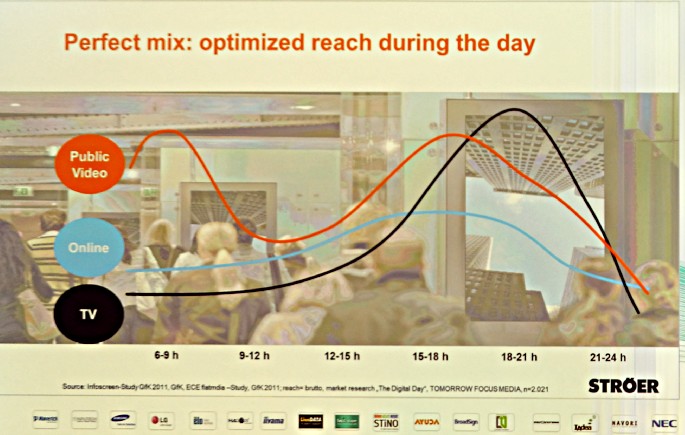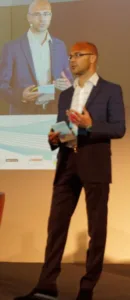Christian Schmalzl is from Ströer which is the dominant player in the DACH DOOH market, with around 60% of the German market. Ströer started in digital signage by buying a company in Germany that did the cross track, projection-based advertising in a number of U Bahns in Germany. Then the firm bought a network from ECE for shopping malls. The company believes it has the best network with 160 railway stations and 19 shopping malls. All of the network can be operated by a single platform which can also be used to drive content to mobile devices.
Ströer believes that 40% – 45% of the German population is exposed to the company’s screens on a monthly basis. The company has made big investments to build a network but revenue, though, was a bit disappointing as most of the money just came from analogue OOH budgets, so the overall market has not grown as much as hoped.
Screens have gradually got more interactive and content creation and development was only done by specialised online agencies. Ströer was not so good with online, so it started buying online companies. It is now one of the biggest suppliers of online content and advertising and is between Google and Yahoo after 31 acquisitions. Overall, the firm is the fourth largest marketer in Germany with Out of Home, video and online and now the company can sell in a more integrated way to brands and companies.
DooH is a “clunky” term, said Schmalzl, while looking at the overall media landscape, more money has been going into more video, into TV and other media such as YouTube. On this basis, Stroer likes the term “Public Video”. Multi-screen is a bigger opportunity than Public Video.
A typical German of 30 to 60 years old sees 1200 ads a month. Only 2 are remembered, typically, so it’s hard for an individual campaign to cut through. More than 1500 videos are broadcast to one viewer in one month. Ströer says combine video with public video and that way you get more impact by any single medium.
Public video is aimed at the workers who are those with the highest income at times of the day when they are not watching TV. Online helps you to reach special targets such as young viewers who are using online media.
Schmalzl said that there are three core pillars of Public Video
* Campaigns – highly parameterised, high availability, premium.
Campaigns are getting better as content is being better developed for public displays – e.g. exploiting portrait displays and realising that simply re-running video from other sources is not good enough.
* Packages – low parameters, short term availability, lower price
Ströer’s packages are sold through “Primetime”, a specialist agency.
* Concepts – combination of advertisng and content that needs a longer lead time to plan and prepare.
The third area of concepts is a new initiative. The firm can create content for particular products combining interactive online ads with public video. An example of a campaign was one created for Sony to try to address the market for young female phone buyers. It was found that they were interested in celebrities, so Ströer worked with Promiflash, which is a website for celebrity gossip in Germany. The campaign was very successful.
In a summary – “a fool with a tool is still a fool”, Schmalzl said. Public Video is a great tool, but it has to be used well. We are still too focused on hardware and technology – the real question is how to connect brands to consumers. Ströer was too driven by its infrastructure, which is why it went online. Integration with other media is critical.
“Real time bullshit” doesn’t work. Don’t just adopt buzzwords from online. Online is truly real time, because you know the user, but Public Video is about audiences – you don’t know who is watching.
In a panel session, Schmalzl was joined by Andreas Soupliotis, who is from Ayuda Media Systems and Radjen van Wilsem from CS Digital Media
Van Wilsem said that his company is working with Shell and can identify cars coming to petrol stations to then know the social class of the driver. You can use video and beacons to communicate with the driver. For example, to get a driver to upgrade their fuel by offering bonus “miles”.
Soupliotis said that his company started as an ERP company. He said that because of real time, the playlist and the loop have to disappear. He said there should not be dedicated media sales channels for DooH.



